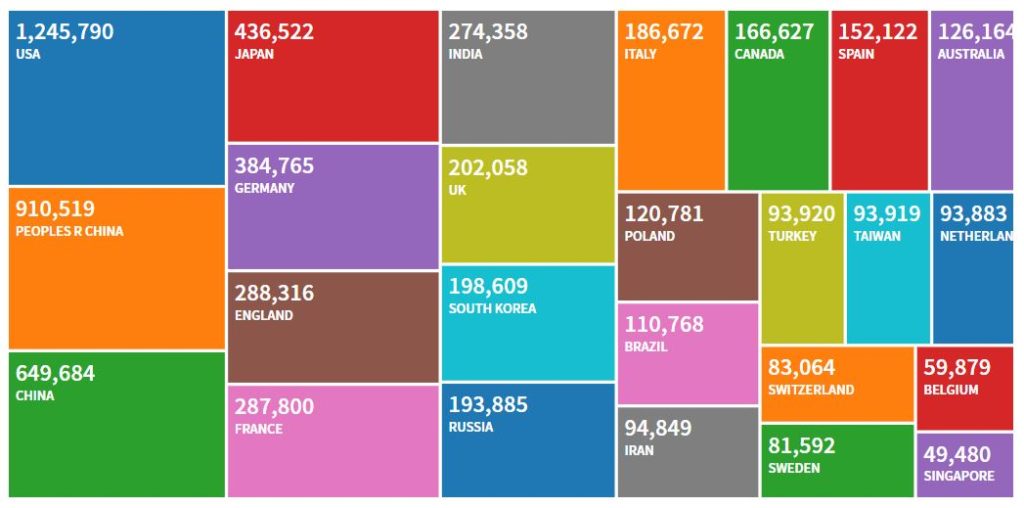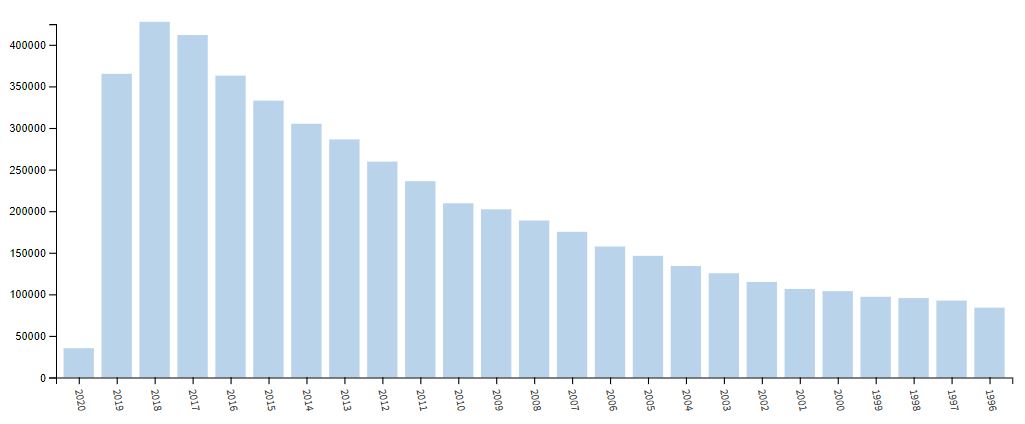Science, Materials and Economic Power!
The world is changing and so is science. I confess myself to be a materials scientist and my life is getting more and more difficult! Why is this so and what is causing this change?

A Changing World
Well, first of all, the amount of papers being published is increasing rapidly and keeping up with the Joneses is getting harder and harder. When I became Associate Professor, in 2000, 100000 papers were published that year. In 2018 it was more than 4 times that.

Materials is a truly multi-disciplinary topic, where the cornerstones are in Engineering, Materials science and Physics. Moreover, applications also range all the way from Pharmacology and through Agriculture to Cell biology and Automotive application. Materials are used in all aspects of human life. This makes Materials research extremely important for us to lead a life as we know it.
The main bulk of research is in Engineering, Materials Science and Physics. Given the profound impact material use has on our everyday life, our daily use of products affect us both as persons and as nations. Moreover, I also see a strong impact indirectly through the manufacturing of materials themselves and the shaping of materials into products. Our capability to do this well affect our resources, energy consumption and carbon footprint. Moreover, climate, nations and power distribution between regions and nations all depends on materials

Research Investment in Materials
The profound impact of materials on our daily lives motivates us to do a significant amount of research on materials. The main research is made in the largest economies in the world, where Sweden interestingly is number 23 in the research ranking!
In 2014 the investment per paper was roughly $45,000 but varied enormously. For some high profile universities, that were the least cost-effective publishers this number was averaging over $75,000 per paper. In 2018 the investment in Materials research was more than $18 900 000 000 around the world.
The importance is also seen through that among the leading countries in materials research there are only the superpower nations and the BRIC nations. China (both China and People’s Republic of China) is also the fastest-growing nation and also the nation with the biggest output by far.

Materials as a Means of Power
As a citizen of the world, I do care about the development of materials as my life and the life of mankind is strongly impacted by material usage. Many leaders around the world see materials as a strategic resource and a source of power to control economic growth.
Historically, in Sweden, when the Falu copper mine was opened, our economy boomed. Sweden produced 80% of the world’s copper during its days of glory. Metallurgical education was created as the first non-military line of education in engineering, even before Civil engineering. This is a strong indication of the importance of materials.
Modern Materials and Trends
Today, the material-use is dominated by integrated circuit production where the leading economies have the best capability in this (USA and Japan for instance), but new applications are popping up. Most people are dependent on transportation and there is a strong shift towards electric transport solutions. The new talk of the town is batteries. Batteries involve many new materials that need new ways to be extracted and to be recycled.
Many country leaders and companies express significant concern about the concentration of cerium, lanthanum and other rare earth metals to China alone. I see that Sweden has here a great possibility to open mining activities to exploit rare earth metals. This would be good for the world carbon footprint as the Swedish electricity, together with Norway are the cleanest and most fossil-free available. Despite this, environmentalists fight against this, even though all, just as I, want electric vehicles and emission-free transports.
Another fact that is surprising is that no one really raised the voice when the western magnesium industry shut down. Not surprising you can find that today China has more or less all the production of primary magnesium. I can only conclude that magnesium is not as strategic a material, as the materials used in batteries.
Today China is developing as an economy and more research on materials is made in China than what was made worldwide when I started my research career. This is not surprising as the Chinese economy and its middle class are growing and gaining financial momentum. Consumerism makes material usage grow and we need to make this as sustainable as possible.
Electric Vehicles and Materials
Now, the main bulk of critical materials used in batteries are geographically located in China. The main bulk of light materials such a Magnesium is located in China. The largest manufacturing and implementation of solar power is made in China. This must also have an impact on transport.
Electric vehicles, running on batteries, is a fast-growing market and everyone knows Tesla. I have previously commented on electric vehicles in my blog, but not connected it to the materials research and material availability.
In terms of market penetration, electric vehicles in Norway is superior with a market share of more than 10% in 2018. The Netherlands comes in as a good second at 1.7%. These two countries have driven the implementation through particular tax incentives, in high-cost and high-salary countries. The market penetration in the land of Tesla, USA, was 0.45% in 2018. In China, it was just shy of 1% in 2018, making the market penetration more than twice that of a high salary country such as the USA. I interpret this as the market for electric vehicles in the USA has different drivers compared to a low salary country such as China has other drivers. I would here argue that the availability of critical materials plays an important role. The availability of critical material drives the industry development and the political will to make the change.
In Sweden, we do not mine these materials, but the establishment of Northvolt is a first step to put us on the map. Volvo’s introduction of its new brand Polestar as a top player with electric drives is another step. Volvo’s connection to China, through Geely, and the availability of critical materials is surely no coincidence.
So What?
Materials science is clearly a means of power and a foundation for a sustainable society. A society that is serious about climate change and carbon footprints invest heavily in materials research. The mort important element is that all materials need to be brought into use and that is through products. Materials development itself will not drive the transformation it is the ability to make products out of the materials that matter. Without this ability, there is no application of services and artificial intelligence. To the economy materials is like due to the car it adds energy. It is like blood to the body, without it the heart does not matter and no other service or function will work without it!
Detta är en bloggtext. Det är skribenten som står för åsikterna som förs fram i texten, inte Jönköping University.


.jpg)


